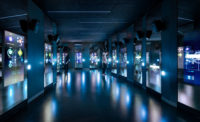Expansive Agnes Denes Retrospective Opens at The Shed in New York

Model for Probability Pyramid-Study for Crystal Pyramid, one of three new Shed commissions of previously unrealized work based on a 1976 drawing by Agnes Denes.
Photo © Dan Bradica. Courtesy The Shed

Agnes Denes, Wheatfield—A Confrontation. Two acres of wheat planted and harvested by the artist on the Battery Park landfill, Manhattan, Summer 1982. Commissioned by Public Art Fund. Courtesy the artist and Leslie Tonkonow Artworks + Projects.
Photo © John McGrall

Installation view of upper-level gallery.
Photo © Dan Bradica. Courtesy The Shed

Tree Mountain–A Living Time Capsule—11,000 Trees, 11,000 People, 400 Years (Triptych), 1992—96.
Courtesy the artist and Leslie Tonkonow Artworks + Projects.

Portrait of Agnes Denes, 2018.
Photo © Jeremy Liebman. Courtesy The Shed





Agnes Denes has been a part of some 600 solo and group shows internationally over her 50-year career, but the retrospective Agnes Denes: Absolutes and Intermediates, opening today at The Shed in Manhattan’s Hudson Yards, is the first comprehensive exhibition of the Hungarian-born artist’s work in New York, the place she’s called home for much of that time. “I am a visual artist, a philosopher, a draftsman, an environmentalist, and a woman,” Denes told The Shed artistic director Alex Poots when asked why there had been no such show before. “I’m hard to fit in one box.”
The Shed, as it turns out, is the perfect box to present her varied body of work, which “spans many mediums, interdisciplinary modes of thinking, experimentation, and pushing boundaries,” according to Poots. Spread out over two floors of expansive galleries within the famously movable structure, designed by Diller Scofidio + Renfro with Rockwell Group and opened earlier this year, the impressive exhibition includes sketches, beautifully precise drawings influenced by math and science, sculptures, and photographs and archival video footage, particularly of Wheatfield-A Confrontation (1982), the monumental public artwork for which she is perhaps best known, where two acres in what became Manhattan’s Battery Park City were planted as a comment on mismanagement of food, waste, energy, commerce, trade, land use, and economics.
While Denes was a climate change activist before the term existed, her prescient works also anticipated other topics facing society today. In her “people works,” she meticulously drew individuals to form structures. As Denes wrote, the works depict “a society composed of individuals who stand in protected isolation, alone but without privacy. They cannot escape the structure yet seem to be fooled by illusions of freedom.” In 1970, she was one of only three women to participate in Software, a very early exhibition at the Jewish Museum in New York about computer technology and information processing.
Though the ailing 88-year-old Denes was unable to make it to the press preview, the exhibition debuts three new Shed commissions of formally unrealized work that she had yet to see, including Model for Probability Pyramid-Study for Crystal Pyramid, a variation of a 1976 drawing by Denes for a theoretical superstructure that would measure 50 meters squared (164 feet) and contain 160,000 glass blocks. The constructed version, on the Shed’s second level, is a striking 30-foot-wide, 17-foot-high pyramid composed of 6,000 3D-printed bricks made of compostable corn-based plastic that is illuminated from within. According to Emma Enderby, senior curator at The Shed and organizer of the retrospective, “Agnes has waited a long time, not just for this exhibition, but for us to catch up with her thinking.”
Agnes Denes: Absolutes and Intermediates is on view until March 22, 2020.









